Quick Menu
Shangri-la's old town burned down in a ten-hour fire that consumed most of the buildings in 2014. Fortunately, no one died. But it was still a tragedy for those whose possessions the flames consumed, as well a blow to the town's booming tourist industry. Yet the destruction of the old town is a bit misleading, for scarcely a handful of truly old buildings were left at the time of the blaze.
Instead, these were new or reconstructed buildings catering to the tourist industry —guesthouses, restaurants, bars and high-priced souvenir shops. The original inhabitants had already nearly all moved out. The authentic old town had been replaced and the new buildings outfitted with fancier wood-carved decorations and very non-traditional picture windows facing the street. The only parts still authentic, like in Lijiang's old town Dayan (丽江大研), were the paving stones.

Historical Zhongdian and its 'opening up'
I was among the first foreigners to visit there in early 1993, just after the county officially opened the doors and it still evoked the atmosphere of a remote frontier outpost. Only a couple of hotels stood on the outskirts of the old town then, which was entirely a residential area with just a few small shops catering to locals.
The people lived in sturdy, two-story houses of timber and rammed earth on stone foundations, a balcony on the second floor, a small yard in front or to the side. People did domestic work here, like carpentry, chopping wood or skinning yak. Some hung hunting trophies or yak skulls from the second floor balcony rafters.
This was the first time local Tibetans had met Westerners, and the encounters were always so friendly I began to think of Zhongdian (中甸) as 'Hello City', after the word I heard a hundred times a day.

On return visits over the next few years I learned some of the local dialect, enabling me to arouse curiosity in the monasteries and invitations to stay overnight in the villages. Tibetans there were just as curious about me as I was about them. With a combination of Chinese and Tibetan, we talked about my experiences in Nepal and with other peoples in the area, even the Akha people I worked with in Thailand.
Zhongdian's Tibetans not only were friendly to foreigners. They also got along well with their Han neighbors. There is a very good historical reason for this. The county sits on a high plateau at about 3,300 meters above sea level and features big barley farms. Harvesting these fields requires two or three families working together a couple of days before each is completed. And the annual yield from this and their other agricultural and pastoral activities make the county's Tibetans rather well off.
Further north, in Diqing County ( 迪庆县), the land is much more rugged, dominated by steep mountains, with much less flat farming land. Here, a single family can harvest its field unaided in less than a day. People are more dependent on animal husbandry and live in smaller, less-endowed houses. In the past, whenever particularly hard times or animal epidemics hit the Tibetans here they formed armed parties that raided the plains of Zhongdian.
Chinese administration in this corner of the southwest did not commence until the Ming Dynasty. Initially it was not direct, either, but through the Mu family rulers of Lijiang until the early eighteenth century. Thus, Naxi soldiers defended Zhongdian's Tibetans from their wilder cousins from further north. Some of them stayed on in Zhongdian and the old town in the 1990s had a Naxi quarter of several houses in the red wood style of Lijiang, in contrast to the whitewashed walls of Tibetan homes.
Later, the Chinese army took over the task of protecting Zhongdian's Tibetans and wound up especially active in the turbulent waning years of the Qing Dynasty. This basically accounts for the friendly relations between Zhongdian's Tibetans and the Han community. They attend each other's festivals and intermarriage is not unusual.

Besides its agriculture, Zhongdian was also an important post on the ancient Tea Horses Road that ran from southern Yunnan all the way to Lhasa. Tibetan ponies were prized by other communities in Yunnan's mountains, but also by the Song Dynasty armies, who faced threats from mounted warriors on their northern frontier.
Pu'er tea from Yunnan had been historically popular in Lhasa, and the traditional caravan route became suddenly important strategically during the Sino-Japanese War. It was used in a new way to ferry supplies from India by caravan from Kalimpong, next to Sikkim, through eastern Tibet, then Zhongdian, Lijiang and Xiaguan (下关).
Some Tibetan merchants from Zhongdian moved to Lijiang during the war, setting up in houses near Dayan's Old Stone Bridge. They helped defend the city against an attack by a brigand gang from Heqing (鹤庆). But when the war ended so too did the lucrative caravan trade, and the Tibetans returned to Zhongdian.

Zhongdian Old Town
The old town didn't have its own market because residents only had to walk a few blocks to the central open-air market in the city. Even the new town looked fairly quaint in the early 90s. Most of the buildings were single story, the tallest being those government offices with Tibetan-style facades.
Restaurants were small and had names like 'The State Guest House Trade Union Dining Room' and 'Apart From The State Guest House Dining Room'. Shops along the main street included several, since relocated, catering to the local Tibetans, selling bolts of wool and brocaded silk, fur hats, wool carpets in Han or Tibetan designs, and clothing in both the local and Lhasa styles.

In the center of town was the open-air market, where Tibetans hawked fruits, snacks, vegetables, lumps of yak cheese, cups and bowls, butter churners, robes and headgear, meat and daggers. Bai people ran a corner offering copper and brass pots, cauldrons, bells, horse trappings and utensils. The stalls were always full and the range of fruits and vegetables surpassed that in Lijiang. Customers included local Han and Tibetans, plus a few resident Bai and occasional Yi and Naxi from the southern part of the county.
Other than a few small shops offering barley spirits, the town didn't offer any nightlife options and mostly closed up entirely after 8pm. When the nights were warm enough, some of the old town residents, especially the young, gathered in the old town's central square for an hour or so of ring dances. This changed during the early summer, when it was mushroom season and villagers brought in their haul for sale in markets that stayed open, along with refreshment stalls, until past midnight.

Heading to the outskirts of town
Besides wandering around the old town, markets in the new town and the nearest villages, visitors always toured the temples. Just outside the southwest quarter of the old town stands the hill called Zhushan, with a small shrine on top that afforded a good view of the old town to the east and the plains to the west. A large temple sits at its base. It had some interesting wall frescoes back then, since replaced.
These included a fresco of local Tibetans and lamas greeting He Long's Red Army forces on the Long March, one of the mythical hero Gesar astride his war horse, one of Chinese ladies in late Qing Dynasty gowns and one of a pussycat. The other temple, on a hill in the southern part of the old town, was less interesting, though the view from the top of the old town was better since you could see the lanes between the houses.

From the old town it was about an hour's pleasant walk or more to Songzanlin Temple, the biggest monastery in the prefecture, dating from the seventeenth century. Or one could rent a bicycle, though the pebbly roads made it difficult to pedal. I wandered freely throughout the monastery, alone or accompanied, often stopped by monks who wanted a chat with a foreigner or wanted me to photograph them, even when they were doing their recitations or performing rituals.
This was the pre-digital camera era and I was not able to show the results immediately. But they were more interested in the camera itself and wanted to look through it, especially when I attached the telephoto lens. After these sessions concluded they would inevitably invite me to have buttered tea with them.

The rise of tourism and the name 'Shangri-la'
Almost as soon as Zhongdian opened for foreign tourists, local agencies began promoting the place as a Shangri-la for visitors. This was pushed in the symbolic sense of a kind of paradise in the mountains. Besides the county's natural and cultural attractions, they also offered treks along He Long's Long March route and the road taken by the Tang Dynasty Princess Wencheng when she journeyed to Lhasa to wed the Tibetan King Srongtsan Gampo. These were obviously directed at Chinese tourists with a sense of their country's history.
The use of the Shangri-la theme soon graduated into claims that Zhongdian was the actual Shangri-la of James Hilton's 1933 novel Lost Horizon. So-called pundits from Kunming and even Beijing claimed their "investigations" proved James Hilton modeled his Shangri-la on Zhongdian. Apparently they hadn't read the book, for Hilton's mythical paradise lies in a forested valley, not a flat plain like Zhongdian.

The triangular snow peak visible from the fictional Shangri-la does resemble the shape of Meili Snow Mountain (梅里雪山), but Meili is only visible several hours' drive north of Zhongdian. Never mind. The purpose of the hype wasn't to prove anything, but to give the county a shining, exotic tourist image. Other places in the Himalaya region made the same claim, such as Bhutan towards the end of the century, but not so vociferously.
In 2001 the city officially changed its name from Zhongdian to Shangri-la, which comes out in Chinese pinyin as Xianggelila (香格里拉). But the old town had already been altering its look and its character since Zhongdian got its airport back in 1996. Flights from Kunming rose, in season, from three or four per week — depending on weather and demand — to several per day during peak travel seasons.
From then on, Zhongdian underwent rapid development. The new town expanded east and north, practically filling up the plain north to the hillock approaching Songzanlin. Tibetans in the old town began moving out, selling off or renting out their houses to aggressive tourist industry businesses.
Within a few years virtually every old house had been replaced by a tourist-oriented establishment, with their signs lining the lanes. Ticket booths went up on the approach to Songzanlin, where the monastery got new gilded roofs, and even at the best vantage point to photograph Napahai Lake (纳帕海) further north.
Old town businesses began calling the place Dukezong, a name I hadn't heard in the 90s. Tibetans I spoke with then referred to it as Jèdâw, the last syllable nasalized, and used that word when they sang songs about it. It sounded like a corruption of the Chinese name Zhongdian, or perhaps of the original Tibetan name of the town— Gyalthang. At any rate, on my last visits in 2008, it was clear that Dukezong was something quite different from the Jèdâw I had known. There was simply no evidence of traditional Tibetan life here anymore. To see that again I had to return to villages I knew around Napahai Lake.
No tourism industry influence had penetrated these villages. New homes had arisen since my first visits, but in the traditional style. The people still lived the same way, did their daily and seasonal chores as before, still wore local Tibetan clothing, and were just as warm and hospitable as ever. About the only change I noticed was that they had cell phones, which they used to call in old acquaintances to meet me again.

Back in the old town for a last stroll, my happy experience in the Napahai villages tempered my feelings of regret for Zhongdian's total transformation. The old way here has gone forever, and I'm quite sure that when reconstruction following the fire ends it will seek to replicate exactly the theme park sort of place it had become. But the fire was not a blow to Shangri-la's indigenous Tibetan culture.
That was unscathed and persists alive and flourishing in the plateau villages. Before James Hilton used the word, Shangri-la was a traditional Tibetan concept of an idyllic place where people lived in harmony with their environment, their gods and each other. In that sense, in view of the lifestyle and manners of the people, to call the place Shangri-la is not out of line. One could argue it's even appropriate.
Editor's note: This article by author Jim Goodman was originally published on his website Black Eagle Flights. There you can find accounts and photos of Goodman's 40 years in China and Southeast Asia. Collections of his works — many of them about Yunnan — can be purchased on Amazon and Lulu. Goodman has also recently founded Delta Tours, where he guides cultural and historical journeys through Vietnam and western Yunnan.
All uncredited images: Jim Goodman
© Copyright 2005-2025 GoKunming.com all rights reserved. This material may not be republished, rewritten or redistributed without permission.


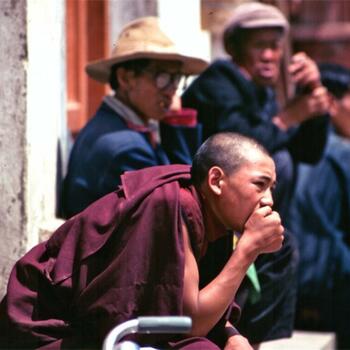
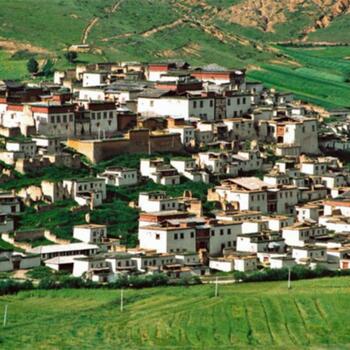


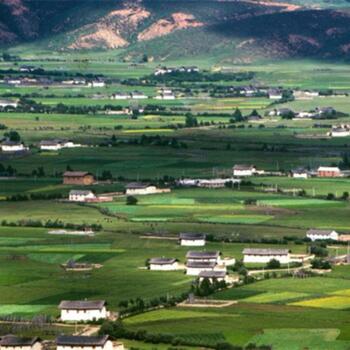



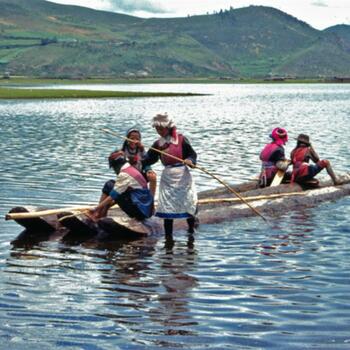
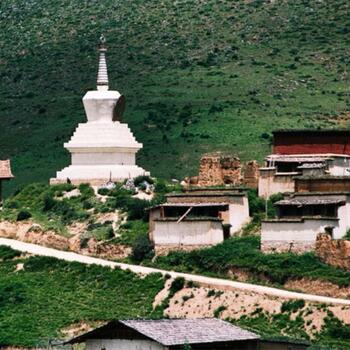









Comments
Great piece by good man Jim. He is like the fabled garuda that soars back into time. The wind horse lungta that strides into town to greet villagers with blessings of goodwill.
Although Shangri-la old town burned down five years ago, replaced by less traditional, tourist-friendly infrastructures... at least one disillusioned townsfolk who survived the carnage, but lost everything, returned to reopen shop in the newly renovated building. He does so out of love of sharing ancestral handicrafts to the world. To preserve their cultural heritage from the burned ashes. Authenticity remains in spirit... in the people, and in their stories.
Great article as always.
One little geographical typo, though, in the 8th paragraph.
The county referred to as "Diqing" (迪庆县) should in fact be "Deqin" (德钦县) 。 Diqing (迪庆州, or 迪庆藏族自治州 in full) is the name of the Tibetan Autonomous Prefecture to which Zhongdian (中甸) aka Shangri-La/Xianggelila (香格里拉县),Deqin (德钦县), and Weixi (维西县) Counties belong.
^was just going to comment on the geographical mixup, but you beat me to it! Just to add, 香格里拉 is a county-level city and the seat of Diqing Prefecture's local government.
Login to comment